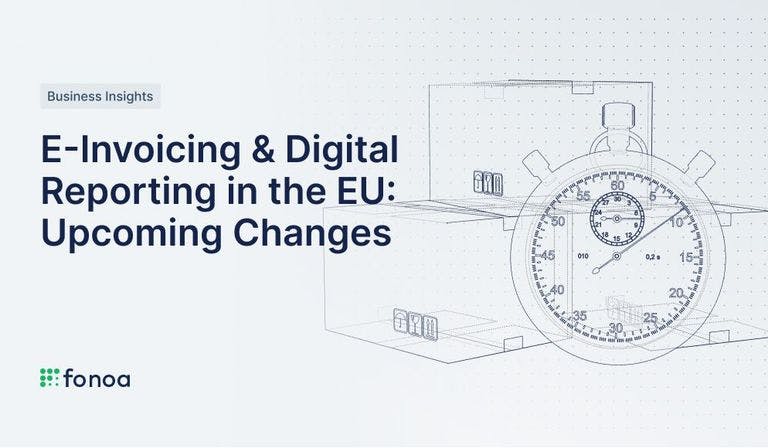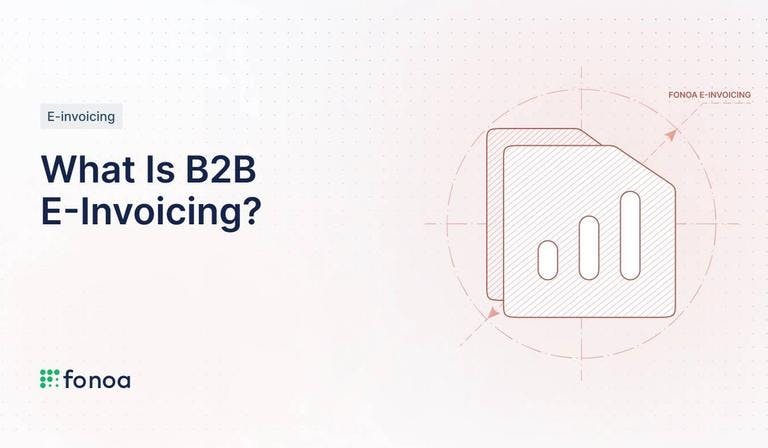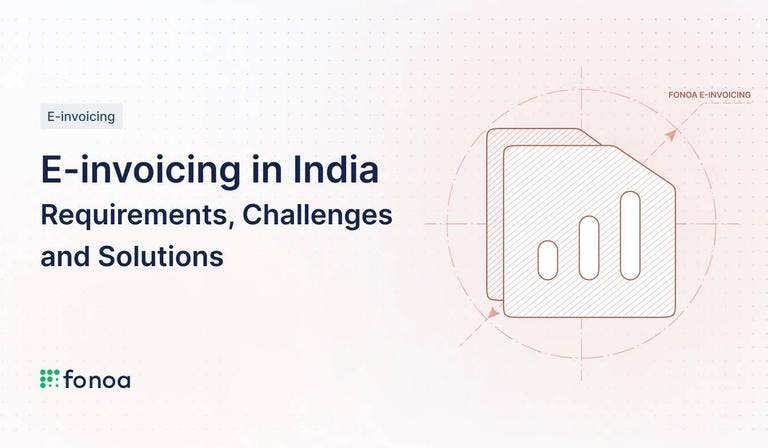Saudi Arabia E-invoicing & Digital Reporting Guide
Saudi Arabia Electronic Invoicing and Digital Reporting Requirements
Questions About E-Invoicing in Saudi Arabia?
Contact our expertsBackground
The E-Invoicing & Reporting System entered into force in two phases:
- First Phase - the Generation Phase. Issuing e-invoices became mandatory in the First Phase starting December 4, 2021. The First Phase includes the rules for the generation of e-invoices and e-notes, as well as provisions related to its processing and record keeping. The aim of this Phase is to eliminate the generation of handwritten invoices or computer-generated invoices through text editing software.
- Second Phase - the Integration Phase. Taxpayers should integrate their systems into ZATCA’s system and are obliged to transfer the e-invoices and notes to ZATCA in the Second Phase. This Phase started on January 1, 2023.
The First Phase: E-invoicing
Any taxable person that is resident in KSA or registered for VAT in Saudi Arabia and any customer or third party that issues a tax invoice on behalf of a resident taxable person should issue electronic invoices in respect of all their transactions containing KSA VAT.
The Second Phase: Digital Reporting
Phase 2 is divided into waves.
- The first wave starts from January 1, 2023, and affects taxpayers whose VATable revenue for 2021 exceeded 3 billion SAR (approximately USD 800 million).
- The second wave starts from July 1, 2023, and affects taxpayers whose VATable revenue for 2021 exceeded half a billion SAR (approximately USD 133 million).
- The third wave : According to the announcement of the Zakat, Tax and Customs Authority (ZATCA), the third wave of the Phase 2 e-invoicing (Integration phase) will affect all taxpayers whose revenues subject to VAT exceeded 250 million SAR (approximately 67 million USD) during 2021 or 2022. Affected businesses should integrate their e-invoicing solutions with ZATCA’s e-invoicing (FATOORA) platform starting from October 1, 2023.
- The fourth wave: The fourth phase affects all taxpayers whose revenues subject to VAT exceeded SAR 150 Million (~USD 40 Million) during 2021 or 2022. VAT-registered taxpayers meeting the criteria should integrate their e-invoicing solutions with (FATOORA) Platform from November 1, 2023, until February 29, 2024.
- The fifth wave: The fifth phase affects all taxpayers whose revenues subject to VAT exceeded SAR 100 Million (~USD 27 Million) during 2021 or 2022. VAT-registered taxpayers meeting the criteria should integrate their e-invoicing solutions with (FATOORA) Platform from December 1, 2023, until March 30, 2024.
- The sixth wave: The sixth phase affects all taxpayers whose revenues subject to VAT exceeded SAR 70 Million (~USD 19 Million) during 2021 or 2022. VAT-registered taxpayers meeting the criteria should integrate their e-invoicing solutions with (FATOORA) Platform from January 1, 2024, until April 30, 2024.
- The seventh wave: The seventh phase includes all taxpayers whose revenues subject to VAT exceed SAR 50 Million (~USD 13 Million) during 2021 or 2022. VAT-registered taxpayers meeting the criteria should integrate their e-invoicing solutions with the FATOORA Platform starting from February 1, 2024 until May 31, 2024.
- The eighth wave: The eighth wave included all taxpayers whose revenues subject to VAT exceed SAR 40 Million (~USD 10.5 Million) during 2021 or 2022. VAT-registered taxpayers meeting the criteria should integrate their e-invoicing solutions with the FATOORA Platform starting from March 1, 2024 until June 31, 2024.
- The ninth wave: The ninth wave includes all taxpayers whose revenues subject to VAT exceed SAR 30 Million (~USD 8 Million) during 2021 or 2022. VAT-registered taxpayers meeting the criteria should integrate their e-invoicing solutions with the FATOORA Platform starting from June 1, 2024.
ZATCA notifies taxpayers individually, and upon this notification, each taxpayer has six months to comply with the integration phase requirements. Compliance timelines will, therefore, vary for each taxpayer depending on the receipt of the notification.
Clearance is required for all the B2B and B2G e-invoices on a real-time basis via APIs before they can be shared with the buyers or customers. This also covers respective debit notes and credit notes.
For B2C transactions, the simplified e-invoices (including their respective debit and credit notes) should be reported to the authorities within 24 hours of their generation and shared with intended customers.
What Types of Businesses Does This Apply to?
All VAT-registered or resident taxpayers in the Kingdom of Saudi Arabia (KSA). Non-resident taxable persons for VAT purposes are excluded.
Governmental Body Responsible for E-invoicing in Saudi Arabia
Penalties for Not Adhering to Saudi Arabia's E-invoice Mandates
Tax evasion is punished by a penalty of not less than the amount of VAT due but cannot exceed three times the value of the goods or services which are the subject of tax evasion.
For violation of the archiving rules, a penalty of SAR 50,000 shall be paid.
Where a non-registered person issues a VAT invoice and, as a result, collects VAT, they shall be fined up to SAR 100,000.
A maximum penalty of SAR 50,000 shall be applied for violating any other provision of the VAT regulations or the VAT law.
Penalties may be doubled for repeat offenders.
What does the e-invoicing process in Saudi Arabia look like?
Tax invoice: An invoice that is usually issued by a Business to another Business (B2B), containing all tax invoice elements.
- The supplier generates an e-invoice file including UUID and hash-chain.
- ZATCA’s platform validates invoice information on a real-time basis.
- If the clearance is successful, ZATCA applies a cryptographic stamp on the file.
- The supplier receives the cleared invoice file.
- The supplier creates the final e-invoice with a QR code/string.
- The supplier shares the invoice with the buyer in a way agreed upon by the parties.
- The buyer can optionally verify invoice clearance status on the platform and/or check the digital signature.
Simplified invoice: An invoice that is usually issued by a Business to consumer (B2C) containing all simplified tax invoice elements.
- The virtual or physical cash register generates invoices with a QR code, including a cryptographic stamp, UUID, and hash-chain.
- The supplier sends a copy to the buyer. I.e., a printed copy or upon agreement between the parties, the simplified tax invoice may be exchanged in any structured or human-readable format, like PDF.
- The customer can optionally verify the invoice's authenticity by scanning the QR code. Request if shared with ZATCA’s platform to asynchronously verify invoice upload.
- Invoice data is stored by the supplier under the required format.
- Invoice data is shared with ZATCA’s platform in batches at a frequency configurable by the taxpayer but at least within 24 hours of issuance.
Is SAF-T Needed in Saudi Arabia?
No.
Questions About E-Invoicing in Saudi Arabia?
Contact our expertsE-Invoicing & Global Tax Automation with Fonoa
One way to comply with Digital Reporting Requirements in Saudi Arabia is to use a provider like Fonoa.
With Fonoa you can:
- Have one integration for your global needs, including Saudi Arabia
- Save time and money by automatically cleaning your data to minimize errors and manual work
- Utilize our validation mechanisms to ensure reporting accuracy, data completeness, full control, and compliance
- Rest assured that transactions are successfully reported or queued for internal investigation with our retry mechanisms
- Get full visibility with our dashboards by filtering criteria, analyzing granular transaction data, and quickly importing /exporting information





